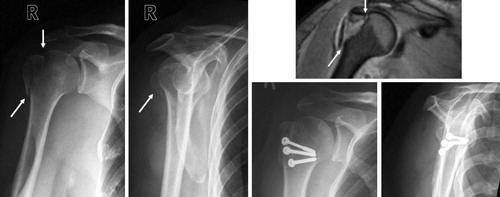Figures & data
Figure 1. The left shoulder of a 64-year-old patient (no. 3, ), who suffered an anterior glenohumeral dislocation of the left shoulder with an avulsed greater tuberosity.

Figure 2. Patient no. 9 () before and after open reduction and internal fixation with cannulated screws of a moderately displaced fracture of the greater tuberosity (white arrows). An MRI scan illustrates the fracture line (white arrows).

Figure 3. Patient no. 6 () before and after open reduction and internal fixation of greater tuberosity fragments with major displacement (white arrows). The multiple fragments were fixed with a screw and a tension wire.

Figure 4. Patient no. 18 () before and after open reduction and plate fixation of a moderately displaced fracture of the greater tuberosity (white arrows).

Table 1. Overview of clinical evaluation considering fragment displacement
Table 2. Active ROM at the time of follow-up examination
Table 3. Synopsis of clinical and radiographic evaluation of patients with isolated greater tuberosity fractures of the humerus
